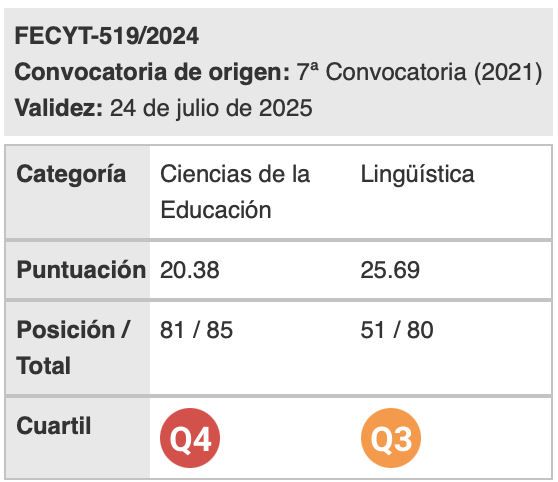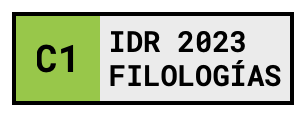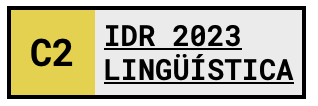What do students talk about? The relevance of content-focused and non-content-focused talk types within peer-interaction CLIL tasks
Palabras clave:
CLIL, talk-types, science learning, TEFL, teacher developmentResumen
This paper observes the different talk types that occur in an instance of peer interaction in Science through English CLIL classroom and attempts at providing a categorization of the students talk and analyzing their function. The sample chosen corresponds to a team of five students in their first year of secondary education from a state school set in a working class neighborhood on the outskirts of Barcelona. Using the framework described by Mercer (2004) and later developed by Pierce & Gilles (2008) and Moate (2011), this study analyzes what the impact of different content-focused and non-content-focused talk types in the construction of knowledge is, together with their influence on the flow of the task through content analysis with the support of conversation and multimodal analysis. Results point out that conversation segments covering content are relevant but, simultaneously, episodes with an interpersonal use of language are also exploited for a wide range of purposes.
Descargas
Citas
Barnes, D. (1976/1992). From communication to curriculum. London: Penguin. Portsmouth, NH: Boynton/Cook-Heinemann.
Berelson, B. (1952). Content analysis in communication research. Glencoe, Ill: Free Press.
Cohen, L., Manion, L. & Morrison, K. (2007). Research methods in education (sixth edition). London and NewYork: Routledge-Taylor & Francis Group.
Escobar Urmeneta, C. & Nussbaum, L. (2008). Tareas de intercambio de información y procesos de aprendizaje en el aula AICLE. In A. Camps & M. Milian (Eds.), Miradas y voces. Investigaciones sobre la educación lingüística y literaria en entornos plurilingüe (pp. 159-178). Barcelona: Graó.
Escobar Urmeneta, C. & Nussbaum, L. (Eds.), (2011). Aprendre en una altra llengua / Learning through another language / Aprender en otra lengua. Bellaterra. Servei de publicacions de la UAB.
Eixarch Domènech, E. (2011). Avaluació i aprenentatge en espais innovadors AICLE. Bellaterra Journal of Teaching and Learning Language and Literature, 4(2), 1-16.
Evnitskaya, N. & Aceros, J.C. (2008). ‘We are a good team’: El contrato didáctico en parejas de aprendices de lengua extranjera. Revista Espanola de Lingüística Aplicada, 21, 45-70.
Evnitskaya, N. & Morton, T. (2011). Knowledge construction, meaning-making and interaction in CLIL science classroom communities of practice. Language and Education, 25(2), 109-127.
Fernández, M., Wegerif, R., Mercer, N. & Rojas-Drummond, S. (2002). Re-conceptualising scaffolding and the Zone of Proximal Development in the context of symmetrical collaborative learning. Journal of Classroom Interaction, 36(2), 40-54.
Fuentes, M.A. & Hernández, E. (2011). From “This is impossible” to “I will make the standard higher”: A close look at interaction in the CLIL classroom. Bellaterra Journal of Teaching and Learning Language and Literature, 4(2), 17-36.
Horrillo, Z. (2009). A study of the on-task and off-task activity carried out by teenage learners during a content and language integrated learning task. The International Journal of Learning, 16 (11), 113-136.
Howe, C. & Mercer, N. (2007). Children’s social development, peer interaction and classroom learning (Primary Review Research Survey 2/1b), Cambridge: University of Cambridge. Faculty of Education.
Howe, C., Tolmie, A., Thurston, A., Topping, K., Christie, D., Livingston, K., et al. (2007). Group work in elementary science: Towards organisational principles for supporting pupil learning. Learning and Instruction, 17, 549-563.
Jefferson, G. (2004). Glossary of transcript symbols with an Introduction. In G. H. Lerner (Ed.), Conversation Analysis: Studies from the First Generation (pp. 13-23). Philadelphia: John Benjamins.
Laplante, B. (1997). Teaching science to language minority students in elementary classrooms, NYSABE Journal, 12, 62-83.
Lemke, J. L. (1990). Talking science: Language, learning and values. Norwood: Ablex Publishing Company.
Markee, N. (2000). Conversation analysis. Mahwah, N.J.: Lawrence Erlbaum. Markee, N. (2008). Toward a learning behaviour tracking methodology for CA-for-SLA. Applied Linguistics, 29(3), 404-442.
Mercer, N. (1995). The Guided construction of knowledge: Talk amongst teachers and learners. Clevedon: Multilingual Matters.
Mercer, N. (1996). The quality of talk in children’s collaborative activity in the classroom. Learning and Instruction, 6(4), 359-377.
Mercer, N. (2004). Sociocultural discourse analysis: analysing classroom talk as a social mode of thinking. Journal of Applied Linguistics, 1(2), 137-168.
Mercer, N. Dawes, L. Wegerif, R. and Sams, C. (2004). Reasoning as a scientist: ways of helping children to use language to learn science. British Educational Journal, 30(3), 359–377.
Mercer, N. & Littleton, K. (2007). Dialogue and the Development of Children’s Thinking. London: Routledge.
Moate, J. (2010). The Integrated Nature of CLIL: A Sociocultural Perspective. International CLIL Research Journal, 1(3), 38-45.
Moate J. (2011). Reconceptualising the Role of Talk in CLIL. Apples – Journal of Applied Language Studies, 5(2), 17–35.
Mondada, L. & Pekarek Doehler, S. (2000). Interaction sociale et cognition située: quels modèles pour la recherche sur l’acquisition des langues? AILE, 12, 147-174.
Mondada, L. & Pekarek-Doehler, S. (2004) Second language acquisition as situated practice: Task accomplishment in the French second language classroom. The Modern Language Journal, 88, 4.
Mondada, L. (2008). Using video for a sequential and multimodal analysis of social interaction: Videotaping institutional telephone calls. Forum: Qualitative Social Research, 9(3), Art. 39.
Moore, E. & Nussbaum, L. (2011). Què aporta l’anàlisi conversacional a la comprensió de les situacions d’AICLE. In Escobar, C., Nussbaum, L. (Eds.), Aprender en otra lengua /Aprendre en una altra llengua (pp. 93-117). Bellaterra: Servei de Publicacions de la UAB.
Moore, E. (2011). Introducció a la transcripció i la simbologia GREIP per a la transcripció multimodal. Unpublished.
Nussbaum, L. & Unamuno, V. (2006). Usos i competencies multilingues d’escolars d’origen immigrant. Bellaterra: Servei de Publicacions de la Universitat Autònoma de Barcelona.
Nussbaum, L. (2008). Construire le plurilinguisme a l’ ecole: de la recherche a l’intervention et de l’intervention a la recherche. In M. Candelier et al. (Eds.), Conscience du plurilinguisme (pp. 125-144). Rennes: Presses Universitaires.
Pekarek Doehler, S. (2010). Conceptual changes and methodological challenges: On language and learning from a conversation analytic perspective on SLA. In P. Seedhouse, S. Walsh and C. Jenks (Eds.), Conceptualising ‘Learning’ in Applied Linguistics (pp. 105-126). Baskingstoke: Palgrave Macmillan.
Pierce, K. and Gilles, C. (2008). From exploratory talk to critical conversations. In N. Mercer and S. Hodgkinson (Eds.), Exploring talk in schools (pp. 37-54). London: Sage.
Ryder, J. and Campbell, L. (1989). ‘Groupsense: when groupwork does not add up to “groupwork”’. Pastoral Care in Education, 7, 22-30.
Vygotsky, L.S. (1962). Thought and Language. Cambridge MA: MIT Press. Vygotsky, L.S. (1978). Mind in society: The development of higher psychological processes. Cambridge, MA: Harvard University Press.
Wood, D., Bruner, J., & Ross, G. (1976). The role of tutoring in problem-solving. Journal of Child Psychology and Child Psychiatry, 17, 89-100.
Descargas
Publicado
Cómo citar
Número
Sección
Licencia
Aquellos autores/as que tengan publicaciones con esta revista, aceptan los términos siguientes:
- Los autores/as conservarán sus derechos de autor y garantizarán a la revista el derecho de primera publicación de su obra, el cuál estará simultáneamente sujeto a la Licencia de reconocimiento de Creative Commons que permite a terceros compartir la obra siempre que se indique su autor y su primera publicación esta revista.
- Los autores/as podrán adoptar otros acuerdos de licencia no exclusiva de distribución de la versión de la obra publicada (p. ej.: depositarla en un archivo telemático institucional o publicarla en un volumen monográfico) siempre que se indique la publicación inicial en esta revista.
- Se permite y recomienda a los autores/as difundir su obra a través de Internet (p. ej.: en archivos telemáticos institucionales o en su página web) antes y durante el proceso de envío, lo cual puede producir intercambios interesantes y aumentar las citas de la obra publicada. (Véase El efecto del acceso abierto).

Revista de Lenguas para fines específicos is licensed under a Creative Commons Reconocimiento-NoComercial-SinObraDerivada 4.0 Internacional License.






















